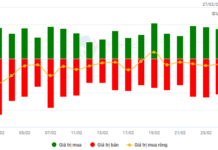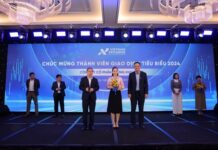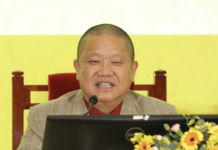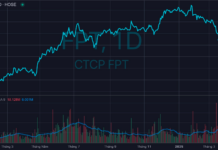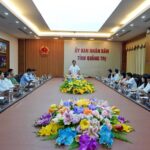At the conference, Mr. Tran Quoc Phuong, Deputy Minister of Planning and Investment, announced the master plan for Binh Duong province for the period 2021-2030, with a vision towards 2050.
Earlier, on August 3, the Prime Minister approved the master plan for Binh Duong province for the period 2021-2030, with a vision towards 2050. The planning scope includes the entire administrative area of Binh Duong province, with a total natural area of nearly 2,700 km2, comprising 9 administrative units at the district level (5 cities: Thu Dau Mot, Thuan An, Di An, Tan Uyen, Ben Cat and 4 districts: Bau Bang, Dau Tieng, Phu Giao, Bac Tan Uyen).
The average economic growth rate for the period 2021-2030 is expected to reach approximately 10%/year, with a per capita GRDP of around USD 15,800 by 2030. By 2030, the economic structure is targeted to comprise 64% industry and construction, 28% services, 2% agriculture, forestry and fisheries, and 6% tax on products minus product subsidies. The urbanization rate is expected to reach 88-90%, with a digital economy accounting for 30% of GRDP. The population by 2030 is projected to be 4.04 million people (including 3.48 million permanent residents and 0.56 million converted residents).

Prime Minister Pham Minh Chinh presents the decision on the master plan for Binh Duong province.
Vice Chairman of the Binh Duong Provincial People’s Committee, Mai Hung Dung, stated that this master plan will address many bottlenecks in the development model of the previous period. It also sets the goal of becoming a centrally-governed city by 2030, with new breakthrough aspects, and aims to be one of the dynamic and comprehensive development centers of Southeast Asia. Binh Duong aims to lead in science, technology, and innovation, becoming a modern industrial and service center, with a synchronously developed socio-economic infrastructure and smart, sustainable urban system, following a green growth model that adapts to climate change and protects the ecological environment.
According to Mr. Dung, this plan will enhance the quality of life for the people, build a prosperous society, ensure national defense and security, and maintain social order and safety. Binh Duong also envisions itself as a responsible link in the extensive development of the Southeast region, contributing to its transformation into a dynamic development hub and a leading center of the country and Southeast Asia in terms of economy, finance, education, training, science, technology, innovation, and digital transformation.

Prime Minister Pham Minh Chinh speaks at the conference.
Speaking at the conference, Prime Minister Pham Minh Chinh affirmed the importance of planning for the rapid, sustainable, and synchronized development of the nation, regions, localities, and sectors. The Prime Minister highly appreciated, commended, and congratulated the important achievements of the Party Committee, authorities, army, and people of Binh Duong province over the past time.
To realize these orientations, Prime Minister Pham Minh Chinh requested Binh Duong to focus on the following key tasks and solutions:
First, promptly and effectively implement the master plan, ensuring compliance and synchronization with the national master plan, regional plans, and sector plans. Efficiently coordinate and manage, ensuring linkage, unity, and sustainable development with a long-term vision, a comprehensive development orientation, and regional connectivity.
Second, maximize resource mobilization, promote historical and cultural traditions, and enhance public-private partnerships. Let public investment lead private investment, and boost strategic infrastructure development, especially in transportation, urban areas, climate change response, and digital infrastructure…
Third, effectively utilize the three dynamic spaces and five key strategies outlined in the master plan. Prioritize resources for the synchronous and efficient implementation of the development space. Strengthen cooperation and linkage in economic development with other localities in the Southeast region. Connect with other regions, domestically and internationally, through the transportation system, and integrate into global supply chains, value chains, and production networks.
Fourth, pay attention to investing in education and training, and develop high-quality human resources. Prioritize policies that focus on human elements to enhance people’s knowledge, train talents, and attract talented individuals.
Fifth, promote administrative procedure reform and improve the business investment environment. Continuously enhance PAPI, PCI, and other indices, and thoroughly prepare projects and sectors to attract investors, especially large and potential ones.

Prime Minister Pham Minh Chinh and Binh Duong provincial leaders present investment approval decisions to enterprises.
The Prime Minister advised Binh Duong to disseminate and promote the master plan through various means to ensure the people’s understanding, support, and compliance. They should also be able to monitor the plan’s implementation and benefit from its outcomes, in the spirit of “the people know, the people discuss, the people do, and the people benefit.”
“The position and role of Binh Duong province are increasingly affirmed in the country’s overall development strategy and in bringing Vietnam into a new era, an era of national advancement,” stated the Prime Minister. He went on to identify six solid foundations for Binh Duong’s development: the great unity within the people and the Party Committee; the heroic historical and cultural traditions; the support of the people; the backing of the international community, businesses, and other localities; the leadership and direction of the Binh Duong Provincial Party Committee; and the province’s own strengths.
Unleashing the Nighttime Economy: The Quest for a Vibrant Quang Tri
The draft proposal for the development of Quang Tri province’s night-time economy until 2025 and the subsequent phase of 2026–2030 envisions a vibrant and dynamic future for the region. The plan focuses on investing in and sustaining the regular operation of 2–3 pedestrian street models in areas with high potential, such as Dong Ha city, Quang Tri town, and Huong Hoa district.
No More Red Eyes: Hunting for Apartments Over $43,000 in Major Cities
The sub-2 billion VND apartments in Ho Chi Minh City have been absent for years, putting immense pressure on the housing market in Vietnam’s most populous city. The resurgence of apartments priced above 1 billion VND in near-central and satellite town locations will help alleviate this bottleneck. This new offering provides a glimmer of hope for homebuyers, promising a chance to secure a home in desirable locations without breaking the bank.
Racing to Complete the High-Speed North-South Railway by 2045
As we delve into the developments regarding the high-speed rail project on the North-South axis, Deputy Prime Minister Tran Hong Ha emphasized the meticulous selection process for technology, management models, and operations. This meticulous process is geared towards establishing a comprehensive and autonomous railway industry and service during a meeting on the 25th of September.




